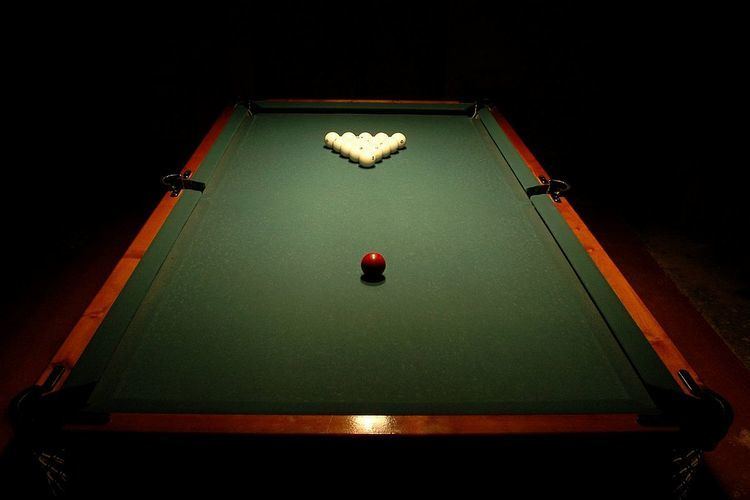 | ||
Russian pyramid, also known as Russian billiard (Russian: ру́сский билья́рд, russky bilyard) or pyramid billiards, is a cue sport that has several differences from Western pool, although game play is still dominated by attempts to pocket (pot) billiard balls. It is played in Russia and also in countries of the former Soviet Union. A variant with colored balls modeled on those of Western pool is called Russian pool. Another variant, kaisa, is popular in Finland.
Contents
Differences from other billiard games
Variations
There are several variations of Russian pyramid. All games begin with fifteen numbered white balls racked in a pyramid pack, as in straight pool or eight-ball. Depending on the game variant some specific balls may have to be in specific positions within the rack. The first player firmly breaks the rack with the cue ball from just in front of (up-table of) the head string (baulk line). The three most common varieties are the following, each of which has slight local variations on the rules: http://www.wpa-pool.com/pdf/web/Official%20International%20IPC%20Rules.pdf
Russian Pyramid World Championship
Since 2000, Russian Pyramid World Championships have been held for Russian pyramid. The world governing body for the sport, establishing published rules and equipment standards, is the International Pyramid Committee, with its largest regional affiliate being the European Pyramid Committee.
Notable players
In popular culture
The so-called "American" version, free pyramid, adapts well to use in fiction because of its simple rules (i.e., the plot does not have to side-track into complicated gameplay explanation), and has featured prominently in notable Russian films such as The Meeting Place Cannot Be Changed (1979) and The New Adventures of the Elusive Avengers (1968). An episode of the popular animated television series Kikoriki has two characters playing the game.
Finnish kaisa
Kaisa or karoliina is a Finnish billiard game, that is a close cousin to Russian pyramid, as it is played with similar equipment (i.e. large balls and tight pockets). However, it is played with two white cueballs, one for each player, two red balls and a yellow ball, the kaisa. A player must pocket a nominated ball, scoring points. Extra points are given from hitting other balls in addition to the target ball. All balls are spotted and the game is played to 60 points. Kaisa is often regarded as the most difficult game of pocket billiards in the world.
Russian pool
American-style pocket billiards (pool) balls have been adapted for use on Russian billiards tables, for playing eight-ball, nine-ball and other pool games. The balls are 68 mm (211⁄16 in) in diameter, like those for pyramid, and thus much larger than the American-style balls they are patterned after (as illustrated in the comparison image).
"Chinese" eight-ball
An American game, fancifully called "Chinese eight-ball" (though not connected with China in any way), is played in a similar manner to Russian pyramid, shooting object balls at the cue ball to carom the former off the latter and into pockets. It is played with typical American pool equipment.
